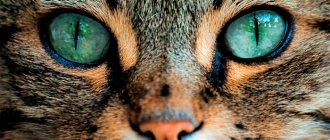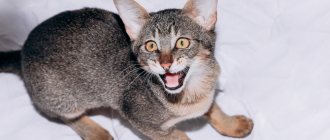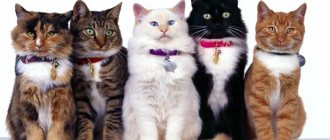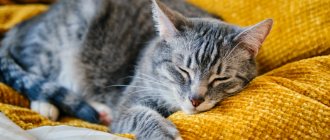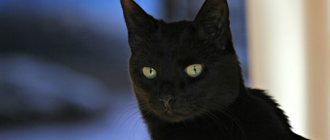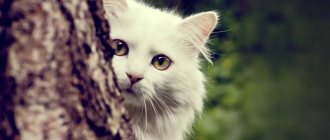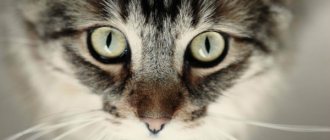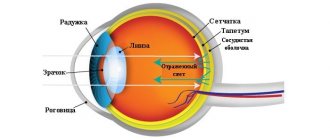Features of cat eyes
Many people know that cats see perfectly in darkness that is impenetrable to humans. But in fact, people exaggerate the visual abilities of cats; unfortunately, their vision is blurry and unclear, and in the daytime, cats see worse than us. Their eyes are extremely sensitive to bright rays of light, and their vertical pupils help protect them from the sun. During the day they squint their eyes, so they like to sleep at this time.
Cats, like humans, have binocular vision, i.e. With each eye they see a certain picture, which overlaps and is transformed into one whole image. Moreover, these animals have a viewing radius of 200 degrees, while humans have only 180.
Visual acuity
- the ability of the eye to perceive two points located at a minimum distance from each other as separate
- the minimum distance at which two points will be visible separately depends on the anatomical and physiological properties of the retina
What does visual acuity depend on?
- on the size of the cones, the refraction of the eye, the width of the pupil, the transparency of the cornea, lens and vitreous body (comprising the light refractive apparatus), the condition of the retina and optic nerve, age
- The diameter of the cones determines the value of maximum visual acuity (the smaller the diameter of the cones, the greater the visual acuity)
Visual angle is the universal basis for expressing visual acuity. The normal sensitivity limit of the eye of most people is 1. In humans, to determine visual acuity, the Golovin-Sivtsev table is used, containing letters, numbers or signs of various sizes. In animals, visual acuity is determined using (Ofri., 2012):
- behavioral test
- electroretinography
The visual acuity of dogs is estimated at 20-40% of the visual acuity of humans, i.e. a dog recognizes an object from 6 meters, while a person recognizes an object from 27 meters.
Shades of colors that a cat can distinguish
From biology we know that the lens of the eye consists of photoreceptors called rods and cones. Thanks to the former, cats have developed special night vision, and the latter - the ability to perceive color. Due to the fact that they have fewer cones than rods, cats have an advantage in nighttime visual acuity.
A curious fact is that in the eye structure of cats there is a tapetum - a specific formation responsible for the scattering of unabsorbed rays. Light is sent by the tapetum to the retina. A person sees the glowing eyes of an animal, but in reality these are reflected rays of light.
Previously, there was an opinion that only achromatic colors (white, black and shades of gray) were available to cats. However, thanks to scientific research on this topic, scientists have come to the conclusion that since cats have cones in their eyes, it means that they distinguish not only black and white colors, but also a spectrum of colors.
Fluffy pets perceive blue and green tones well, distinguish between purple colors, yellow ones are often confused with white ones, and red, brown and orange colors are not available to them.
Tips for choosing accessories based on color
In big cities, cats sit at home, without the opportunity to frolic in the fresh air. Owners want to diversify the life of their pets, pamper them and make them move. So that they don't become fat and lazy. This is where pet stores come to the rescue with a huge selection of toys.
In order not to buy bright and useless ones in vain, the owner must remember the peculiarities of cats’ vision. This knowledge will help you choose accessories for your pets. Cats are good at distinguishing objects of green, blue, yellow and green and gray colors. Therefore, they will run after such toys with excitement. And, most likely, to react indifferently to beautiful and fashionable reds. The cat will react the same way to beds and feeders. Green and blue will become his favorite ones, he can simply ignore the rest.
Mr. Cat Recommends: Cats' Vision in the Dark
Good vision in the dark is due to the peculiarities of the structure of the retina of a cat's eye. It is equipped with light-sensitive receptors that allow you to easily navigate in poor lighting conditions. Due to these features, cats are better at determining their location, unlike other animals and people.
Scientists have found that in pitch darkness without a light source, cats also cannot distinguish objects; their visual acuity decreases, just like the human eye. However, in poor lighting, an animal’s visual functions work more productively than humans. This is why indoor cats like dark rooms so much.
It has been revealed that in low light, a cat's visual acuity is 7 times higher than that of humans. Such features are due to the genetic component of the development of feline animals, which hunted mainly at night. In twilight, dark forests, visual acuity becomes a decisive factor for successful hunting. One of the main merits of free orientation in the dark is also the pet’s good spatial memory.
Does your pet see something we don’t see?
Whiskered pets were often accused of conspiring with the forces of evil, attributing magical abilities to them. But over time, most of the superstitions were explained by felinologists.
Differences from human vision and perception
Having figured out what kind of vision cats have, it is easy to identify its main differences from humans. Possible superpowers are confirmed by a wider viewing angle, faster perception speed and clearer visibility in low light.
Most owners have noticed more than once how their pets stare at one point for a very long time or suddenly jump up and start running around the room. At such moments, their pupils dilate and their fur stands on end. This behavior makes you very uncomfortable and even a little scary.
Perception of the world
Nature has provided for the use of each organ in accordance with its purpose. For hunting, it is more important for a cat not to miss the movements of the prey, and factors such as coat color and body length do not play a role.
The animal’s hearing organs, which distinguish sounds by their height and strength, help them to more fully perceive the surrounding space. In addition, they have excellent sense of touch and sensitive vibrissae organs located on the muzzle and tail.
For cats, smells play an even more significant role than vision. It is important for an animal to smell new objects, and not just look at them. However, visual perception is a real survival mechanism.
Do cats see the paranormal world?
Cats are considered magical animals. Esotericists say that because of their aura, cats become guardians of not only the owner, but also his entire family. The furry pet not only protects the home from the penetration of otherworldly entities, but also drives them out.
There is an old custom according to which, when moving into a new house, the cat must be brought in first. The fact is that if an otherworldly force is detected in the home, the animal will expel it with the help of its biofields. Mediums say that a pet is able to expel ghosts or souls of the deceased from a home, so it is impossible for a cat to be nearby during spiritualistic seances.
Auxiliary organs
In addition to the eyeball, the cat’s visual system also includes auxiliary organs that provide its protection. These bodies include:
- Upper eyelid.
- Lower eyelid.
- Third eyelid.
Anatomy of a cat's eye
Since cats do not have eyelashes in the traditional sense, they need organs that provide protection to the eye shell from environmental particles - dust and microbes. These tasks are performed by all three eyelids, which, in addition to protecting the eye, are responsible for its nutrition and distribution of lubricating fluids throughout the cornea to prevent drying out.
Third eyelid
The third eyelid (nictitating membrane) performs several important functions, which should be discussed in more detail. In a healthy state, the third eyelid is invisible to the naked eye. It can be detected only in those rare moments when the fold of the conjunctiva straightens and covers a large surface of the eye - for example, when the cat's head is tilted at a certain angle.
If you can discern a third eyelid on your pet's eye, it's time to take him to the vet.
Also, the third eyelid becomes noticeable when it is inflamed or due to other pathological processes in the cat’s body. A visible third eyelid is a good reason to immediately consult a veterinarian.
The functions of the nictitating membrane include:
- production and distribution of tear fluid throughout the eye membrane;
- retention of the tear film on the cornea;
- protection of the cornea from mechanical damage and injury;
- immunological protection against microbes.
The third eyelid is present not only in cats and other mammals, but also in humans
It should be clarified that the exact functions of the third century remain largely unexplored to this day. In determining the significance of the nictitating membrane, zoologists move from the opposite direction, determining what damage damage to the third eyelid brings to the eye.
The person preserved the “remains” of the third eyelid in the inner corner of the eyes
Both cats and humans have a third eyelid. The difference in the structure of the human eye is that the third eyelid plays the role of a vestigial organ, which has turned into a small bulge in the inner corner of the eye. The reason for this change in the third eyelid lies in the fact that a person does not grab prey with his teeth and does not eat from the ground, which reduces the likelihood of contamination of the eye and eliminates the need for additional protection of the eye shell.
The functions of the third century have long been of interest to scientists, but the purpose of this organ remains a mystery.
Rudiment or useful device?
At the beginning of the twentieth century, the nictitating membrane was treated as a completely unnecessary organ. Moreover, the practice of removing the third eyelid was widespread, which supposedly simplified the life of a pet, ridding it of this “relic of the past.” Such careless actions led to an imbalance in the eye: the visual system lost the ability to produce a sufficient amount of tear fluid, which led to dry eye syndrome. The third eyelid was partly regulated with the help of the nervous system, and therefore its removal did not pass without a trace for her.
A hundred years ago, cats underwent surgery to remove the third eyelid, which caused harm to the animal.
Today, scientists are inclined to believe that the third eyelid is not an exception, but rather the norm among mammals and birds. Its absence (or rather, modification) in primates and humans is an interesting curiosity, and not a rule that should apply to all other species.
How far can a cat see
It was believed that the cat perfectly recognizes objects that are nearby. Indeed, this opinion has been confirmed by scientific research, cats are myopic. They can perfectly distinguish things only at a distance of up to 20 meters, and see the rest blurry, without outlines. Objects located near the muzzle or at a distance of up to 0.5 meters are also difficult to see. In these cases, their whiskers and ears help them observe the world around them. The cat's eye is best suited for detecting rapid movement. People only notice shadows, but an animal will see a rodent running in detail.
Binocular vision and wide viewing angle
Among all domesticated animals, the cat has the largest eyes in comparison with the overall body size. Her eyes are located almost on the same plane and are directed forward, so the visual fields of the left and right eyes overlap. The signal from the visual analyzers in the brain is converted into a single picture. This vision is called stereoscopic (or binocular), thanks to which the cat perfectly estimates the distance to visible objects, as well as the speed of their movement.
Cats' eyes are not only large, but also more convex than those of humans, so their viewing angle is on average 200-205°, versus 180° for humans.
True, individuals with a flattened muzzle (Persian and Scottish breeds) have a smaller field of peripheral vision than cats with an elongated muzzle and slanted eyes. In any case, cat vision captures a much larger field in the periphery, plus it is good at distinguishing the movement of objects in this area.
But the ability to clearly see objects at a distance of more than 7 meters is not available to cats. A person is normally able to clearly examine an object from a distance of 30-60 meters.
The cat also has difficulty seeing objects that are right under its nose, and its vision is inferior to that of humans in its ability to quickly focus. In a cat's vision, this ability is 2-3 times worse, that is, the animal cannot quickly reconfigure visual perception from a distant object to a close one, and vice versa.
What cats see in the mirror and on TV
Very often we see a cat throwing itself at a mirror. If he hisses and arches his back, he is ready to attack. The pet sees itself in the reflection, but does not understand it. When meeting another animal, additional information is needed, in particular from the whiskers. But no smells or tactile sensations that complement the overall picture of holistic perception enter the brain. The result is something like cognitive dissonance, i.e. conflict with inconsistency between incoming information and established ideas.
Scientific opinion regarding television says that the animal sees only the flickering on the monitor and nothing else. Sometimes the movements on the screens put him into a state of stupor. However, many people know that cats love to watch television programs. They watch birds, tigers, lions and others with interest. At the end of the transmission, they leave the room. A reasonable explanation for these facts has not yet been found.
